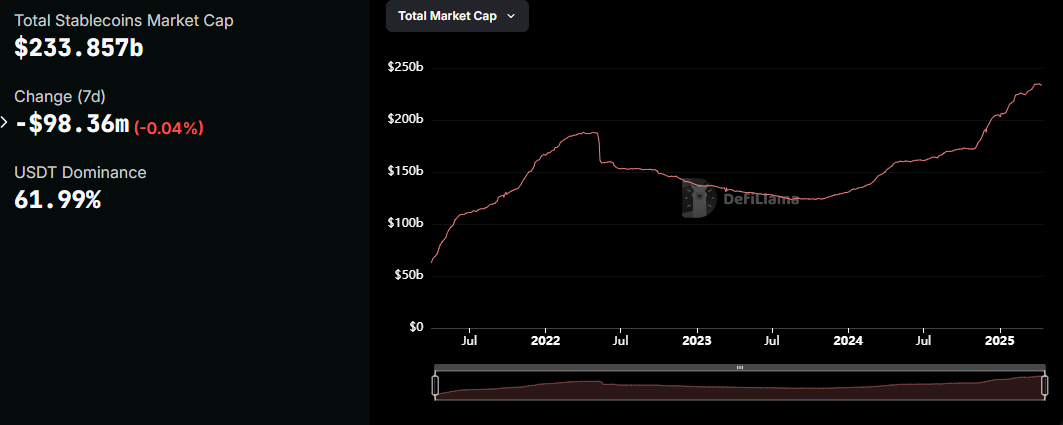Standard Chartered Points to Possible $2 Trillion Surge in Stablecoin Volume Amid New US Legislation
Contents
-
Standard Chartered forecasts stablecoin volume surging from $230 billion to $2 trillion by 2028, spurred by new US legislation.
-
The GENIUS and STABLE Acts will enforce transparency, reserves, and anti-money laundering compliance, ensuring stablecoin growth.
-
Italy’s Economy Minister warns US-backed stablecoins could threaten European economic sovereignty, urging the EU to expedite the digital euro.
Explore how new US legislation could propel stablecoin volumes to $2 trillion by 2028, impacting global finance and European sovereignty.
Stablecoin Volume To Go Berserk, Standard Chartered Says
Stablecoins are today’s top US crypto news, drawing context from the recently introduced GENIUS Act and STABLE Act. The bipartisan GENIUS Act balances state and federal oversight, supporting innovation. Specifically, it creates a federal framework mandating 1:1 asset reserves, transparency, and anti-money laundering compliance for issuers.
Meanwhile, the STABLE Act reinforces this with strict reserve rules and audits, ensuring stability and consumer trust. These laws aim to protect users while fostering growth in digital currencies, paving the way for secure stablecoin adoption.
According to Standard Chartered, the new legislation, which is due for implementation in a few months, could cause stablecoin volume outstanding to go berserk.
“The volume of stablecoins outstanding is set to explode after the US passes legislation in a few months from now,” Standard Chartered Head of Digital Asset Research Geoff Kendrick told COINOTAG.
Kendrick says stablecoins will go from $230 billion to $2 trillion by the end of 2028, adding that growth will require an extra $1.6 trillion of US Treasury bills to be held as reserves.
“That is all of the planned new Treasury bill issuance over that period,” he added.
The Standard Chartered executive is not alone. Italy’s Economy Minister Giancarlo Giorgetti shares the sentiment, anticipating stablecoin growth amid the Trump administration’s deregulation push.
European Sovereignty at Risk?
Speaking at a financial forum in Milan, Giorgetti expressed deep concern over the rise of US dollar-backed stablecoins and the broader implications of Washington’s crypto shift. He acknowledged that stablecoins offer European citizens a convenient, banking-independent way to make cross-border payments.
However, he sees its growing adoption, particularly those backed by the US dollar, as a threat to the euro’s role as a global reference currency.
Giorgetti warns that the US’ growing stablecoin policy could pose a more significant threat to European economic sovereignty than trade tariffs introduced under President Donald Trump.
“The general focus these days is on the impact of trade tariffs. However, even more dangerous is the new US policy on cryptocurrencies and in particular that on dollar-denominated stablecoins,” Giorgetti said.
He urged EU leaders to expedite plans for the digital euro. It is a central bank digital currency (CBDC) designed to offer Europeans a homegrown alternative to dollar-based crypto payment tools.
“Stablecoins give savers the opportunity to invest in risk-free assets and a widely accepted means of payment without needing a US bank account. Its appeal for people of the Eurozone should not be underestimated,” Giorgetti warned.
Under new guidance from the US SEC (Securities and Exchange Commission), some stablecoins will be exempt from securities regulation, provided they meet strict standards.
In the same tone, traditional finance (TradFi) is moving swiftly to address the dollar dominance of stablecoins. Through its Onyx platform, JPMorgan Chase has added British pound (GBP) accounts to its Kinexys blockchain-based payments network.
The move addresses a glaring shortfall in the $230 billion stablecoin market, where over 95% of tokens are USD-denominated.
By expanding Kinexys to include GBP (following recent euro integrations), JPMorgan hopes to position itself as a key infrastructure provider for stablecoin-like settlements in other currencies.
Chart of the Day

Stablecoin market cap. Source: DefiLlama
Byte-Sized Alpha
- Trump administration will interview candidates to replace Jerome Powell as Fed Chair.
- Bolivia reverses its decision to use cryptocurrency for fuel imports, citing a return to dollar-based transactions amid energy sector instability.
- Trump administration is considering using tariff revenues to fund a national Bitcoin reserve, signaling a shift toward digital assets.
- Global liquidity hit a record in April 2025, with gold surging past $3,200 and Bitcoin lagging 30% below its all-time high.
- Bitcoin funds attract new capital after a seven-day lull. On Monday, BlackRock’s IBIT led inflows with $36.72 million.
- Ethereum gains traction among retail investors amid ongoing ETF outflows.
- XRP price’s 8% rise could trigger $400 million in liquidations, but not anytime soon.
Conclusion
This landscape signals a monumental shift in how stablecoins operate globally. As US legislation unfolds, key players in the crypto space are poised for opportunities not just in liquidity growth but also in navigating emerging regulatory frameworks. Stakeholders should stay informed and adapt to these evolving dynamics to maximize their engagement with digital assets.
Marisol Navaro
Comments
Yorumlar
Other Articles
Bitcoin Surges to $93,888: How Venezuela-US Tensions Triggered a Crypto Rally
January 5, 2026 at 07:04 AM UTC
AI Data Centers May Strain Water Supplies in US High-Stress Regions
January 1, 2026 at 08:17 PM UTC
BitMine Boosts Ethereum Stake to 461K ETH, Eyes Network Share Growth
January 1, 2026 at 08:06 PM UTC
